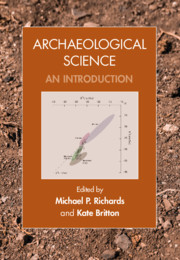Book contents
- Archaeological Science
- Archaeological Science
- Copyright page
- Contents
- Figures
- Tables
- Contributors
- Acknowledgements
- Part I Introduction
- Part II Biomolecular Archaeology
- Part III Bioarchaeology
- Part IV Environmental Archaeology
- Part V Materials Analysis
- 14 Ceramics
- 15 Glass
- 16 Metals
- 17 Lithics
- Part VI Absolute Dating Methods
- Index
- References
16 - Metals
from Part V - Materials Analysis
Published online by Cambridge University Press: 19 December 2019
- Archaeological Science
- Archaeological Science
- Copyright page
- Contents
- Figures
- Tables
- Contributors
- Acknowledgements
- Part I Introduction
- Part II Biomolecular Archaeology
- Part III Bioarchaeology
- Part IV Environmental Archaeology
- Part V Materials Analysis
- 14 Ceramics
- 15 Glass
- 16 Metals
- 17 Lithics
- Part VI Absolute Dating Methods
- Index
- References
Summary
Metals have always fascinated humans, for reasons ranging from practical through aesthetic to philosophical considerations. More than for other materials, this fascination can be seen to cover both the production of metals and their use. In most societies, ceramics play a much more fundamental and ubiquitous role than metals, but it is only the high-end varieties, such as porcelain, terra sigillata or colourful glazed wares, that attract particular attention. Few people, past and present, philosophise about the transformational processes involved in changing the plastic, pliable clay into a hard and rigid water-resistant ceramic. Interest in wool, linen and other fibres is almost entirely restricted to our obsession with fashion and the social expressions it allows, but the production processes involved are a minority interest and outside the general folklore. In contrast, metals play not only a role in many societies’ mythology and moral narrative, assigning notions of nobility, strength and value to them, but even their production forms the basis for many metaphors, tales and symbolic expressions. The phrase ‘trial by fire’ makes direct reference to cupellation, an obscure and specialised metallurgical operation in which the quality of gold or silver is tested for any debasement by copper – but as a metaphor it already appears in the Old Testament, and is still understood today. ‘Brass’ evokes a very different connotation from ‘gold’ when talking about values and appearances. Prospects of a ‘mother lode’ or ‘bonanza’ resonate with many people even if they are not metal prospectors. In archaeology, metals not only make a disproportionately high contribution to structuring major periods of cultural development and evolution, but archaeometallurgists specialising in the study of their production have even been referred to as a ‘priesthood’ trying to exploit secret knowledge and driving hidden agendas, potentially not in the best interest of the wider scholarly community (Doonan and Day 2007); a charge that to the best of my knowledge has not been levelled against any other science-based discipline within archaeology, such as archaeo-botany or -zoology, or ceramic petrography. Clearly, metals fascinate humans, whether it is for the right or wrong reasons.
- Type
- Chapter
- Information
- Archaeological ScienceAn Introduction, pp. 365 - 386Publisher: Cambridge University PressPrint publication year: 2020



